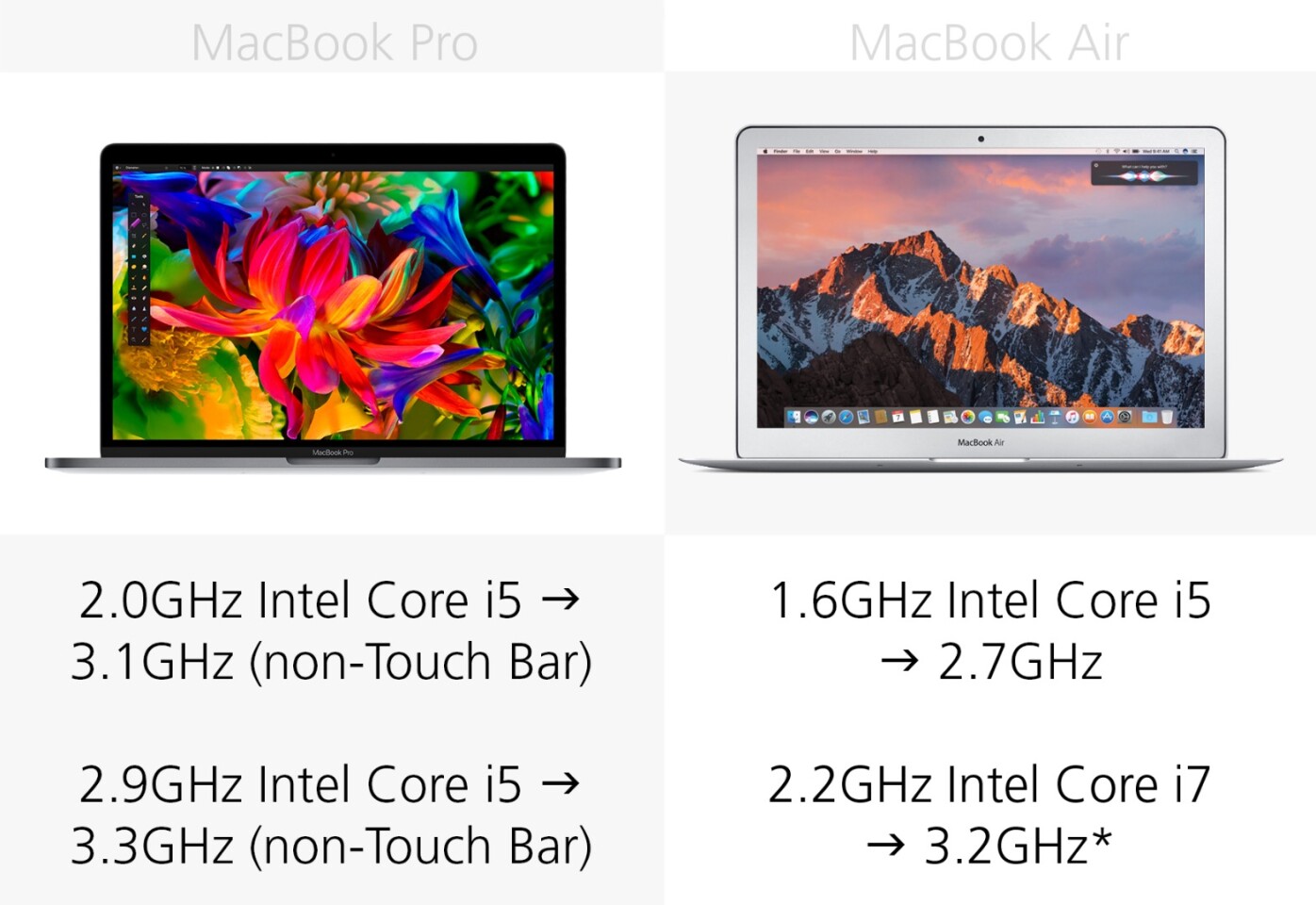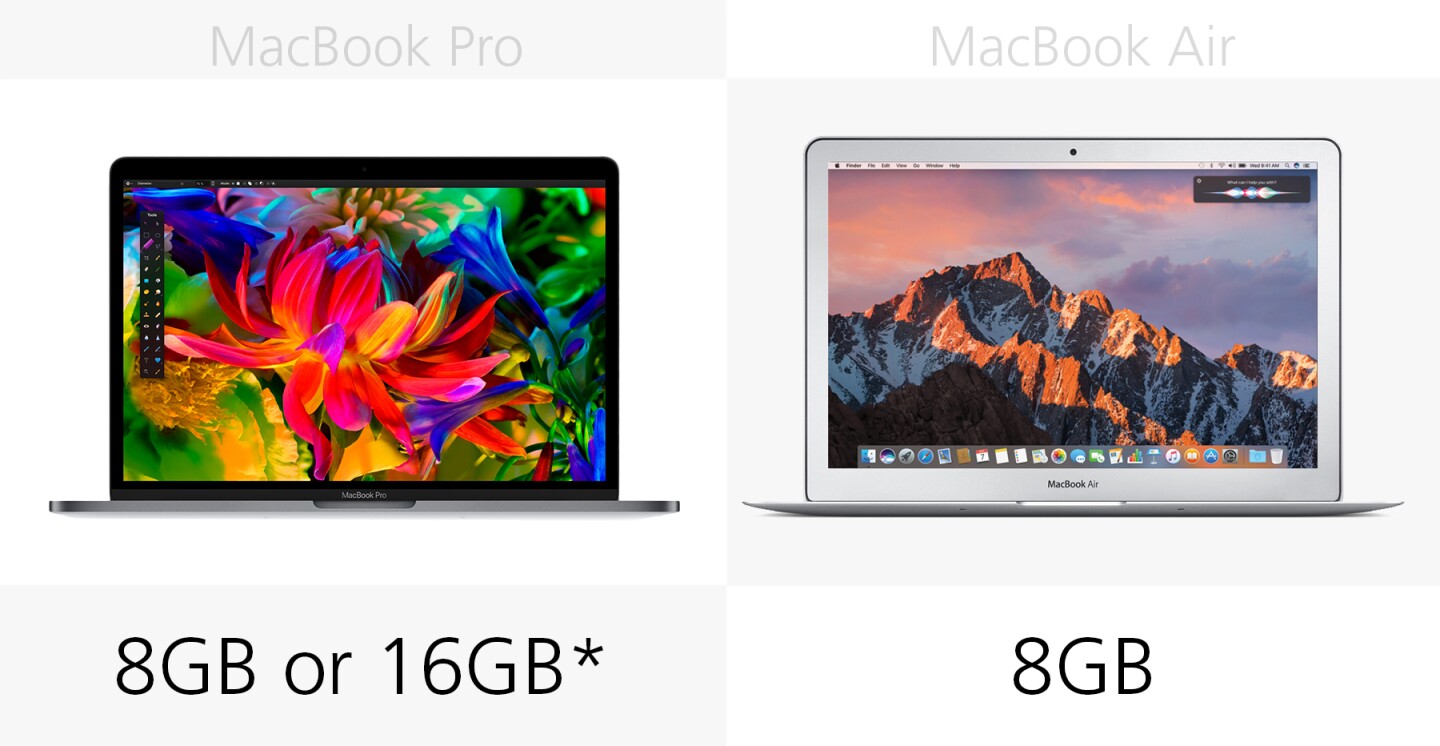When the MacBook Air was first introduced, it was the thinnest, lightest laptop that Apple had to offer – and consumers paid a premium for it. Historically, MacBook Pros have been bigger and more substantial, with the hardware and internals to match. But the release of the 2016 MacBook Pros (and other models leading up to it) threw that hierarchy out the window. It's worth taking a careful look at these two offerings before assuming that the more expensive "Pro" model is right for you.
Note: For the sake of this comparison, we're comparing the two variants of the 13-inch 2016 MacBook Pros – the non-Touch Bar model and the Touch Bar version – with the 13-inch MacBook Air.
Size

As Phil Schiller emphasized during the 2016 MacBook Pro launch event, the 13-inch Pros are smaller than the Air. The Air does have a tapered profile, but it's 9 millimeters thicker than the Pro at its widest point. At its narrowest point, it's less than 2 millimeters thinner.
Weight

The Pro is a tad more dense, however. It weighs 20 grams more (1.5 percent heavier) than the bigger MacBook Air.
Build

No surprises here – both machines have Apple's characteristic aluminum unibody.
Colors

Both laptops come in silver. The new MacBook Pros also have a darker "space gray" variant.
Display size

The two different builds have the same 13.3-inch screen size.
Display resolution

MacBook Pro has dropped its "with Retina display" branding, probably because a good display is practically a given in a high-end laptop. Still, the Pro has a high-resolution display that trounces the Air's pixel density.
Trackpad type

Force Touch trackpads first made their appearance in last year's MacBook Pros and, soon after, the 12-inch MacBook. On this type of trackpad, the glass panel is solid-state. It doesn't actually move, but pressure sensors and haptic feedback combine to make it feel like it does. MacBook Pros carry on this technology in this year's models, and the trackpad itself has been made bigger.
The MacBook Air still rocks a moving trackpad, which many of us are familiar with: It physically moves when you click it, and the diving board hinge mechanism means it's a little easier to click on the bottom than it is on the top.
Touch Bar

The new 2016 MacBook Pros have a "Touch Bar" option, which is Apple's newest bit of proprietary input technology. The Touch Bar replaces the traditional Fn keys at the top of the keyboard, and it populates with dynamic shortcuts that change according to your preferences and the app that you're using. Note that the Touch Bar model is more expensive than the version with Fn keys, and it has a few higher-end internals as well.
Fingerprint sensor

If you pay extra for the Touch Bar on the MacBook Pro, you get a Touch ID fingerprint sensor as well. It's integrated into the Touch Bar.
There's no fingerprint sensor on non-Touch Bar MacBook Pros or the MacBook Air.
Processor

There are different processors in the non-Touch Bar and Touch Bar MacBook Pros. The base model has a 2.0 GHz Intel Core i5, which Turbo Boosts to a 3.1 GHz clock speed. The more expensive Touch Bar model has the same chip, with a little more speed: The 2.9 GHz i5 with Turbo Boost reaches 3.3 GHz clock speeds.
Off the shelves, the MacBook Air comes with a 1.6GHz i5 processor, Turbo Boosted to 2.7GHz. However, if you order directly from Apple, you can also get a custom configuration with a 2.2GHz Intel Core i7 that hits 3.2GHz. This option is well worth considering if you want the MacBook Air configuration with Pro-rivaling performance.
Graphics

The MacBook Pro has better graphics. The base model has Intel Iris 540, and the Touch Bar-equipped machines have Intel Iris 550.
RAM

Both machines have 8 GB of RAM. You can also custom order a 16 GB version of the MacBook Pro.
Storage

The Pros are available with either 256 or 512 GB of built-in storage. It's also possible to special order a 1 TB version.
The Airs come with either 128 or 256 GB of storage. The 512 GB level is available in custom configurations.
Thunderbolt ports

Here's where things start getting interesting. When it comes to ports, the MacBook Pro takes a minimalist approach. There are two Thunderbolt 3/USB-C ports on the base model, and four on the Touch bar version.
The MacBook Air has two last-gen (non-reversible, non-USB-C compatible) Thunderbolt 2 ports.
USB 3.0 ports

This year's MacBook Pros have zero traditional USB Type A ports, clearing them out in favor of the new and reversible Type C. The MacBook Air has two old-school USBs.
SD card slot

MacBook Pros do not have an SD card slot, but the Air does. Photographers who aren't yet using wireless transfers will need to pick up an adapter for the new Pros.
Charging port

To charge your MacBook Pro, you'll need to use one of the aforementioned Thunderbolt ports. The MacBook Air has a dedicated charging port and MagSafe charger, so you won't need to encroach on those precious ports.
On the higher-end (Touch Bar) MacBook Pros, though, this can be an advantage: with USB-C ports on both sides of the machine, you can choose which side you charge on.
Headphone jack

Both laptops have a dedicated headphone jack. It's the traditional prong jack, so if you have an iPhone 7 or 7 Plus, you won't have anywhere to plug in the Lightning port headphones.
Battery

According to Apple's estimates, the Air should get up to two hours more of battery life than either Pro.
Webcam

Both machines have a 720p webcam, for applications like Skype, FaceTime or other video chat/conferencing software.
Software

Since this is Apple we're talking about, both machines run its latest desktop operating system, macOS Sierra.
Release

The current iteration of the MacBook Air was released in March 2015. The 2016 MacBook Pros are brand new. The non-Touch Bar versions started shipping in October and the Touch Bar versions start shipping this month.
Starting price

The base model Air starts out US$500 cheaper than the Pro. That's a significant amount, so it complicates this decision.
The Air has a few things the MacBook Pro doesn't, namely traditional ports. Using this year's MacBook Pro, especially for professional applications, is likely to demand the use of adapters and other peripherals. Therein lies potential for frustration.
On the other hand, it's always tempting to opt for the latest and greatest, which in this case would be the year-and-a-half newer MacBook Pro. It has a far superior display and graphics, and for an additional $300, it's got the fancy new Touch Bar as well.
Still, for maximum forward and backward utility, it's tempting to get a custom-configured Air with a speedy processor. That way you have a powerful machine that's not reliant on adapters, though its years-old form factor and last-gen display could make it look a little aged.
For a more in-depth look, read New Atlas' review of the MacBook Air or first impressions of the non-Touch Bar MacBook Pro. We will post full-length reviews of the new MacBook Pros in due course.



























